There is no space for discussion on how important agriculture is in modern society, the whole world in fact depends on agriculture as a mean of supply for food, feed, fiber, and, increasingly, bio fuels. Hence Without a productive, highly efficient and strong agricultural system, society would collapse almost overnight.
A booming population growth combined with an increase in demand for food and agricultural products are putting a lot of pressure on earth’s agricultural system, in fact more and more is being demanded from the global agricultural system in the hopes of keeping up with these increasing demands. In order words, to satisfy those needs global agricultural production must at least increase by 70 %. To keep up with those demands, an ecosystem degradation is taking place, in order to increase global agricultural spaces.
Another problem that we are faced with, is the decline in freshwater supply. Due to an increase in world population which in turn led to an increase in agricultural products, more water is being used to grow the rising number of agricultural areas. Most of the globe are using water in excess for agriculture.
A different concept threatening any chances of sustainability is the non-efficient food management implemented by most countries. One third of the food globally produced goes to waste in developed countries, developing and underdeveloped countries on the other hand are suffering of a huge shortage in food and agricultural products. This huge gap in food distribution is proof that current methods are unsustainable.
Last, but not least, compared to any other human activity, agriculture and land use is the greatest source of greenhouse gas emission, since they are producing more gas than all the world’s passenger cars, trucks, trains and planes, all electricity generation or manufacturing.
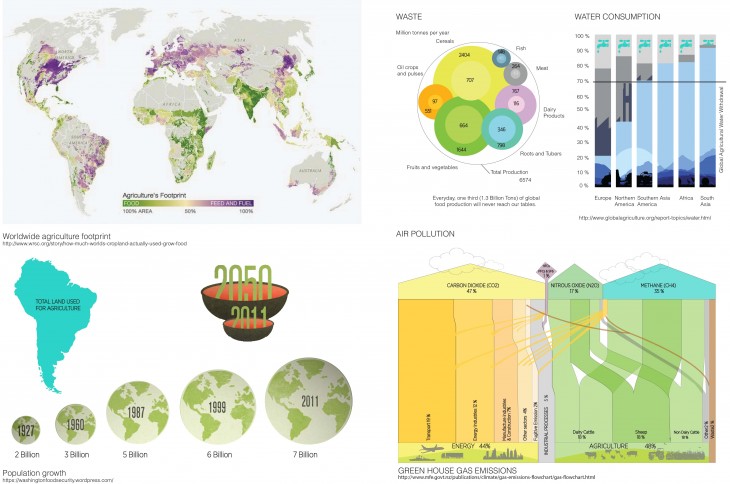
In order for us to know how much and the type of food we should provide, we have to determine our citizens’ diets. These differences will directly impact our neighborhood’s infrastructure. Further analysis showed inefficiencies in some diets while others are great to achieve self-sufficiency.
Should our 25,000 citizens be meat consumers alone, we would need to farm animals into our neighborhood. If we decide to use the farming method which uses the less amount of land and is being adopted indoors, factory farming, we would be farming our animals in the cruelest and inhuman way: today’s factory farms cram animals by the thousands into filthy, windowless sheds and stuffed into wire cages, metal crates, and other torturous devices. But other than land use, we still have the problem of energy consumption, air pollution and producing food for the factory farmed animals. All of the above, and for the sake of being self-sufficient, led us to consider only vegetarian diet.
Vegetarianism will involve wheat, beans, fruits, vegetables but most importantly, dairy products and eggs which are still products that do not involve slaughtering animals but come from them. In order to provide them, we would have to farm animals in our self- sufficient neighborhood, which would not solve our issue regarding our environment, air pollution and our land use. And so, if we do decide to go vegetarian, we would have to import our dairy products along with our wheat that will require land 3 to 4 times bigger than our neighborhood to feed 25,000 people. Meaning a total of 35 % of imported food in our neighborhood and 65 % of local production is not what we would opt for a self- sufficient neighborhood.
Finally, we have decided to try vegan-ism. Vegans abstain from the use of animal products entirely.
Because of its deficiencies of many nutrients, this diet is very sensitive and cannot only be measured by kilograms of food per day but also by the amount of calcium, protein, iron and vitamin D one consumes.
Therefore in order to achieve self- sufficiency we have decided that our citizens should be considered vegans.
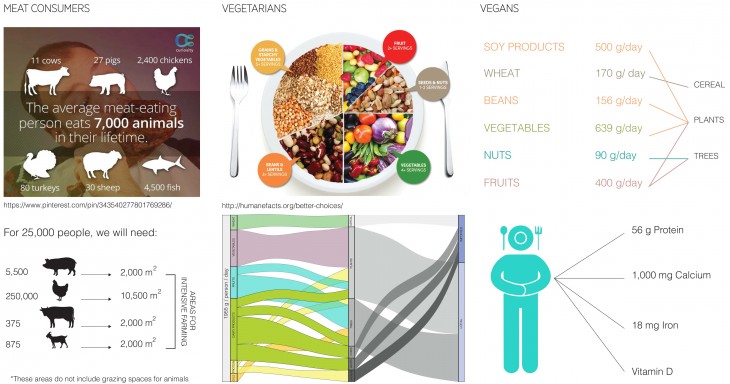
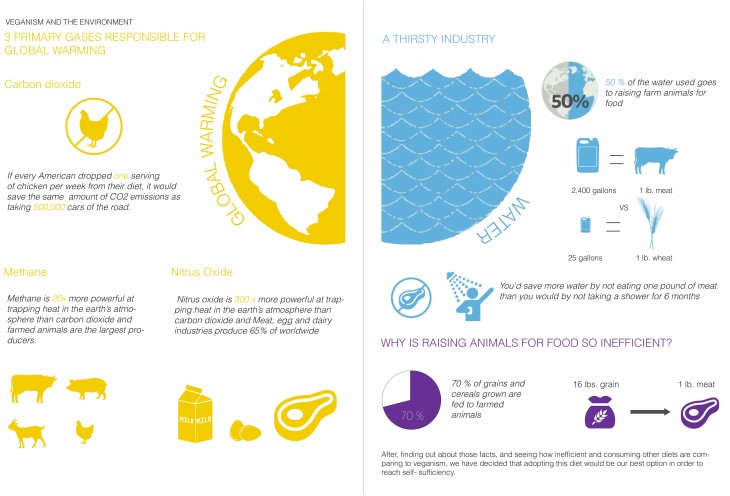
As mentioned, providing food for vegans means taking into consideration the different nutrients that their body needs, and because of the lack of meat and dairy products, vegans have to substitute those food groups by consuming larger amounts of other ones. For instance, meat and dairy products rich in protein and calcium will be replaced by large consumption of beans, fruits and vegetables.
In order for us to be able to provide all of the essential nutrients in our self-sufficient neighborhood, and decide the amount of land that will dedicate to each crops, the type of agriculture that we will use for each, and where they will grow, we analyzed all of the fruits and vegetables that we will grow in our neighborhood by their amount of protein, calcium and iron.
Other factors were taken into consideration such as whether they grow on trees or not, whether they can grow in our weather or not (Barcelona’s) and their water consumption.
The fruits and vegetables that will be allotted the most amount of land to grow will be the most nutritious ones that consume the less water.
The area of land dedicated to each fruit may vary depending on whether they can grow on trees or not. Considering trees such as dates and olives cannot be planted on rooftops due to their large roots and heavy loads.
Thus, trees will grow outdoor and will be limited by their production according to the weather.
For instance, coconut trees are rich in protein and calcium, but cannot be accorded a big amount of land because they will have to grow outdoors and our weather conditions do not promote their growth.
Our priority crops will be dedicated to fruits such as dates, olives, gooseberries, grapefruit, kiwi and lemon. As for vegetables: Garlic, Kale, Spinach, Swiss chards, Okra, Corn, Bitter melon, Arugula will be accorded the most areas.
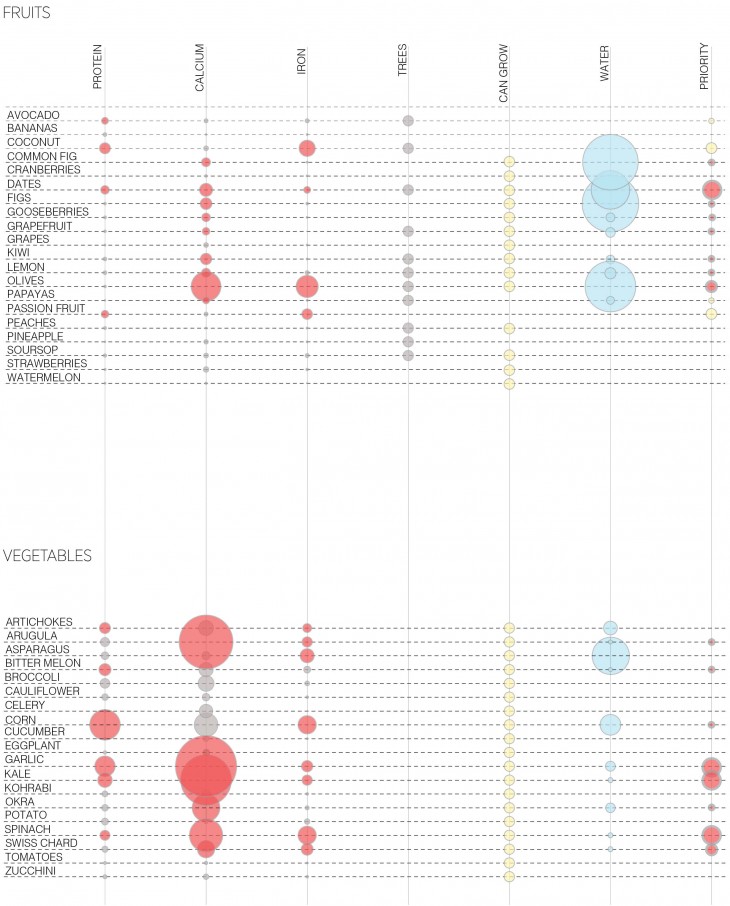
The seasonality chart for each type of fruits and vegetables will help us decide how to distribute our crops.
Fruits that grow on trees are excluded from the seasonality chart since we do not have a choice but to grow them outdoors.
Concerning the fruits that grow on plants and all vegetables, we will take into consideration their seasonality in order to decide where to distribute them.
Crops that grow outdoors during most of the year, if not all year, will be allotted our outdoor crop lands.
These crops are for instance Avocados, Bananas, Strawberries, Arugulas, Broccolis, Cauliflower, Garlic, Kale, Spinach, Swiss chards.
The other crops such as Common figs, Cranberries, Figs, Gooseberries, Grapes, Watermelon, Artichokes, Asparagus, Bitter melon, Celery, Corn, Cucumber, Eggplant, Kohlrabi, Okra, Potato, Tomatoes and Zucchini will be allotted smaller to bigger area of lands according to their nutrients and water consumptions.
These crops will grow indoor where the temperature will be more controlled in order to alleviate for the deficiencies found in outdoor farming.
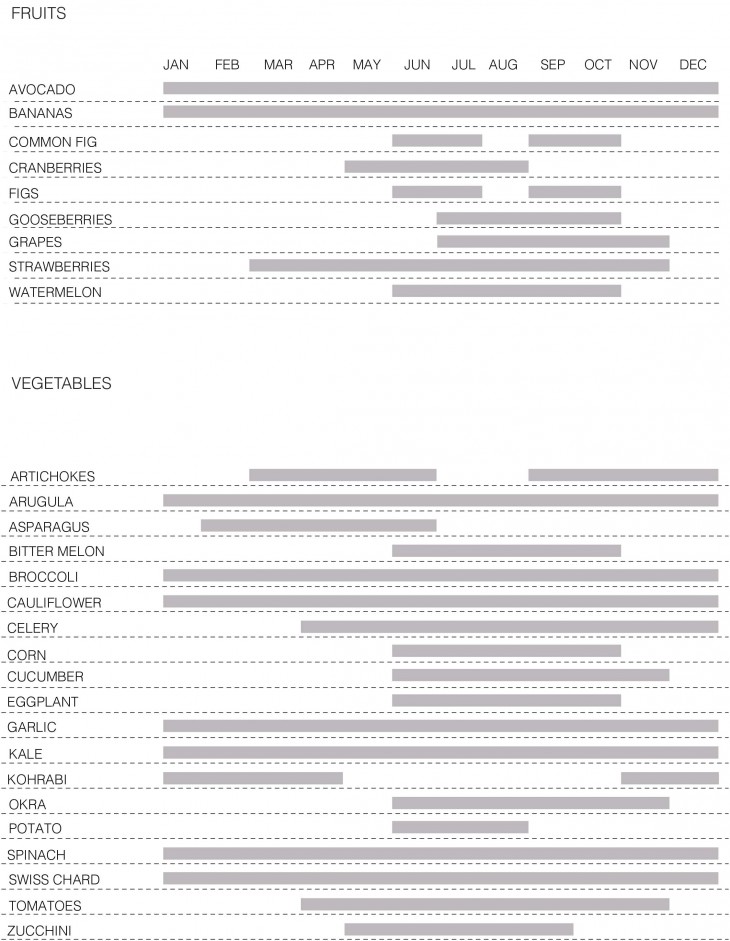
We have established our different methods of agriculture that will be used into our self-sufficient neighborhood.
Permaculture is a system of agricultural and social design principles centered on simulating or directly utilizing the patterns and features observed in natural ecosystems. This system will be used in a green area of our neighborhood of approximately 40,000 m² that can be used as a public park where we also grow part of our food. It will mostly be dedicated for our fruit trees such as Dates, Olives, Kiwi, Lemon and Grapefruit.
Green Rooftops is an efficient way of using areas that are inevitably here but are not being used. Rooftop farming is cleanse the air with the release of O2 and absorption of CO2 by the plants. And so other than growing food, roof gardens not only gives us aesthetically good looking rooftops, but also reduces the amount of Co2 emissions in our neighborhood.
Our green rooftops will be used for honey bees colonies and growing foods with all-year cycles such as Broccolis, Cauliflower, Kale, Garlic etc…
Greenhouse Rooftops Farming, like green rooftops is also a way to use the rooftop areas for our benefit. The difference is that the agriculture will be practiced in an indoor greenhouse where we will also place solar panels.
Vertical Farming is simply a stack of greenhouses on top of each other. One indoor acre of vertical farming is actually the equivalent of ten outdoor acres, due to the fact that we use hydroponics and aeroponics to control the climate and growth of the different types of food.
Indoor agriculture can control the growing food’s seasonality and produce it during all year by using hydroponics and aeroponics. We will use those methods to produce all types of vegetables, fruits growing on plants and beans.
The pedestrian streets of our neighborhood could grow our nut supply and providing them with aesthetic qualities.
LED Farming is a technology used for indoor farming in a faster and more efficient way (use of less water and energy). The technology is being applied nowadays but due to its very recent results, we decided to implement it as a testing building. A technology for food center.
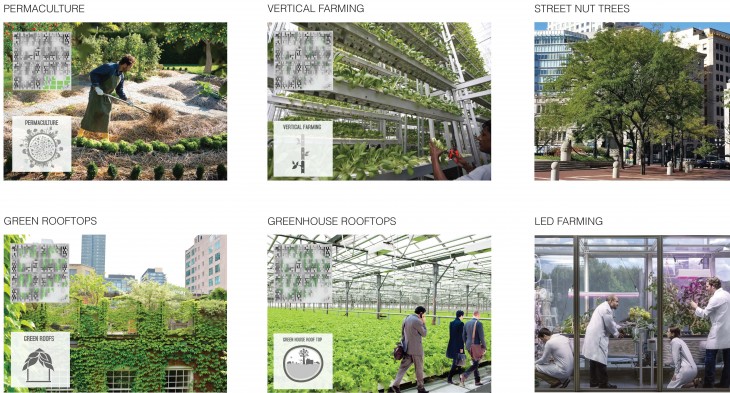
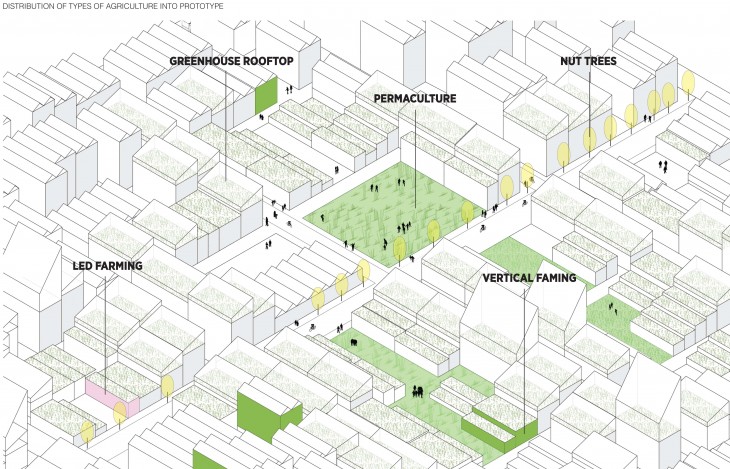
Vitamin D is one of the main missing nutrient in a vegan’s diet which can cause bone pain and fatigue. Its main source usually is the sunlight, but one cannot only count on it, especially if we consider the changements of weather conditions.
For these reasons, we have to reconsider our main source of vitamin D for our 25,000 citizens. We discovered that mushrooms are one of the rare type of foods that are rich in vitamin D. For that, we will double our mushroom production.
Mushroom farming is different than any other kind and our mushrooms will be farmed in the underground level of our vertical farms in a total area of 2000 m². Farming mushrooms involve different steps that are illustrated below.
Honey bee farming in an urban environment is important especially when we have rooftop agriculture. Honey bees play a major role in the pollination; one third of our food that we grow actually comes from honey bee pollination. Therefore adding honeybees colonies to our rooftop not only could be a nice hobby for the inhabitants, but also will promote our agricultural number.
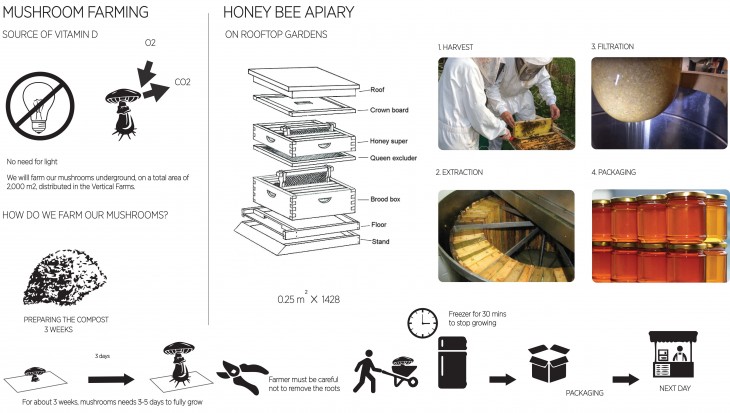
We have established a diet for our vegans that is composed of an average of amount of different types of food in order for our vegans to eat and be healthy. Those amounts of foods have been taken on the basis of 1955 g/ day and divided into percentages for each type accordingly to one’s needs.
Accordingly to those values we have been able to reach a certain logic of production that has been distributed through our very varied production system and in conclusion, only 10% of the food will be imported most of it being our wheat. Therefore our self-sufficient neighborhood will be able to produce a total of 90% of our required foods for 25,000 vegans.
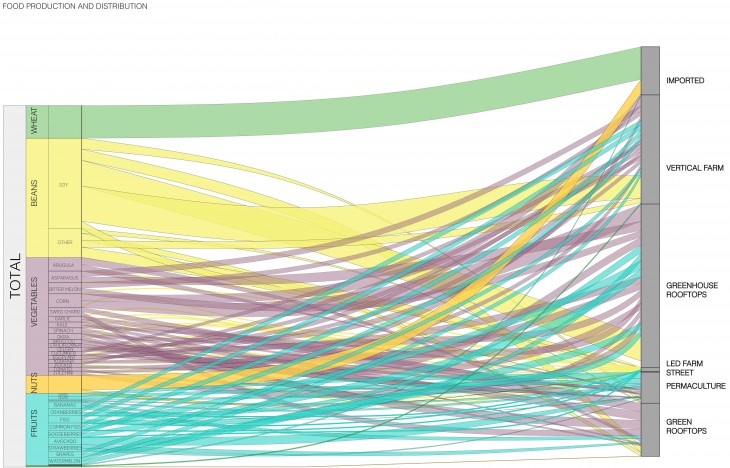
Urban Planning for Self-Sufficient Neighborhood Prototype is a project of IaaC, Institute for Advanced Architecture of Catalonia developed at Master in City and Technology in 2015 by:
Students: Sherine Zein
Faculty: Vicente Guallart and Rodrigo Rubio
Assistants: Ruxandra Iancu and Alessio Verdolino